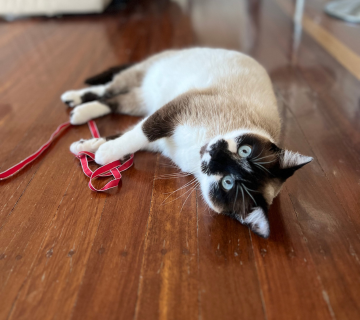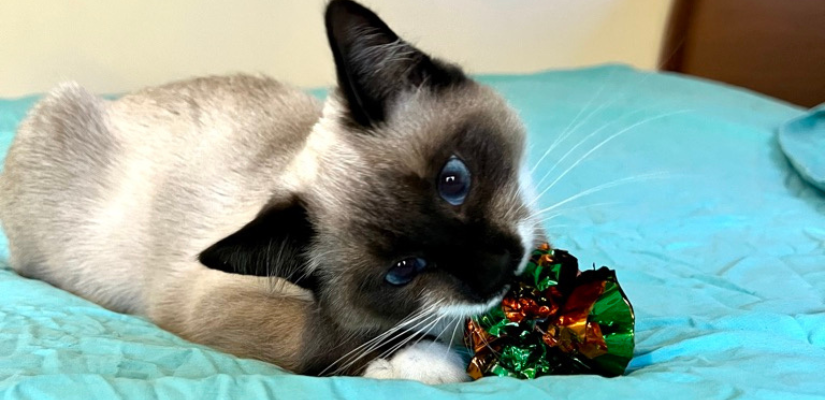Cats have been our beloved companions for centuries, providing affection, comfort, and even a bit of mystery to our lives. However, for cat owners, sleep can sometimes become a luxury. The peaceful hours of rest that we long for can be disrupted by our feline friends’ nocturnal activities. So can cats sleep in a seperate room and still be ok.
This guide aims to explore the intricate world of cat sleep, the significance of a good night’s sleep for both cats and their owners, the various sleep dilemmas that cat parents face, and ultimately, whether the solution to these dilemmas might involve your cat sleeping in a separate room.
Let’s find out if your cat would benefit from their own room to sleep in.
Understanding Cat Sleep Patterns
Cats are intriguing creatures when it comes to sleep. They have unique sleeping patterns that often baffle their human companions. To make an informed decision about your cat’s sleeping arrangements, it’s essential to first understand that unlike humans, who tend to sleep for extended periods at night, cats are crepuscular creatures. This means they are most active during the twilight hours of dawn and dusk.
Understanding these patterns requires delving into the evolutionary reasons behind them. Cats, as natural hunters, adapted to this schedule over thousands of years. They are wired to be most alert and active when their prey is also active. In the wild, this increased their chances of a successful hunt.
For domestic cats, these instincts are still present. While they might not be hunting prey in the same way as their wild ancestors, they exhibit similar patterns. This often leads to nighttime activities that can be disruptive for their human companions. This includes, of course, the “zoomies”, which can easily disturb us humans. Or the wacking you in the head or loud meowing at 4-5am to inform you they are hungry.
The Importance of Sleep for Cats
Before we delve into potential solutions for sleep dilemmas, let’s take a moment to consider why sleep is crucial for your cat’s overall well-being. Cats, like all animals, require sleep to rest, repair their bodies, and maintain optimal health.
Sleep plays a vital role in a cat’s physical health. It’s during sleep that their bodies can repair tissues, synthesise proteins, and release growth hormones. This is especially important for kittens, as they need ample sleep for proper growth and development. But rest isn’t just about physical health; it’s also crucial for mental well-being.
For cats, sleep is a time for their brains to process information. It’s when they can sort through all the sights, sounds, and experiences they’ve encountered. This is an essential part of their learning and memory retention. In fact, studies suggest that cats deprived of sleep can suffer from memory and cognitive problems – just like us!
The Sleep Dilemma
While we adore our cats, their nighttime escapades can be quite challenging for us. From chasing invisible prey to performing acrobatics on our furniture, they can create disturbances that leave their human companions sleep-deprived and bleary-eyed.
Some of the common sleep disruptions faced by cat owners include the notorious “zoomies”, when your cat suddenly bursts into a frenzy of activity, racing around your home like a tiny tornado. Then there are the meowing sessions, during which your cat might serenade you with a medley of vocalisations that could wake the soundest sleeper. And let’s not forget the perils of a playful feline friend who thinks your bed is an amusement park.
These nighttime antics can leave cat owners exhausted and desperate for a good night’s sleep. So, what’s the solution? Could having your cat sleep in a separate room be the answer to your sleep dilemmas?
Benefits of Separation
Is having your cat sleep in a separate room the solution to your sleep woes?
When your cat’s nocturnal activities are taking a toll on your rest, it can lead to frustration and even health problems due to sleep deprivation. By providing your cat with a separate sleeping space, you can enjoy uninterrupted slumber, allowing you to wake up refreshed and ready to face the day.
Additionally, separation can lead to reduced nighttime disturbances. Your cat can indulge in their crepuscular instincts without waking you up with playtime or vocalisations. This can lead to a more harmonious living environment, as you won’t find yourself constantly tired and irritable due to lack of sleep.
There is also the opportunity to foster independence in your feline companion. While cats are known for their independence, they can also become quite dependent on their human companions, especially during the night. By allowing your cat to sleep separately, you encourage them to be more self-reliant.
Of course, these benefits come with considerations and challenges, which we’ll explore in more detail as we delve deeper into this topic.
Preparing a Separate Sleeping Space
Should you decide that separation is the way to go, creating a comfortable and secure sleeping area for your cat becomes paramount.
While in some cases a bed on the floor might suffice, an entirely separate room, with the door closed, might be the most suitable location for your cat’s separate sleeping area. This ensures that they’re entirely out of your space and cannot disturb you. When choosing a room, ensure it is well-ventilated, maintaining a comfortable temperature. Cats are sensitive to temperature extremes, so a cozy environment is essential for their rest.
Now, let’s consider the bedding. Choosing the right bedding materials can make a significant difference in your cat’s comfort. Opt for soft and comfortable bedding that provides adequate insulation. Cats love to snuggle into warm, plush surfaces. Consider placing their favourite blanket or a piece of your clothing in their sleeping area for added comfort and reassurance. Cats like to sleep on your bed because it smells like you and therefore feels safe, so adding familiar items to the cat’s new bed will help them settle in.
Next, think about providing essential amenities. Cats, even when sleeping separately, require access to their necessities. Ensure their sleeping area includes a clean litter box, fresh water, food, and some of their favourite toys. This helps create a self-contained, comfortable space where they can find everything they need during the night. Making sure there are also enrichment activities in the room like a scratching post, a window to look out of, and space to roam and run will also keep their “zoomies” contained in the room. You could add a running wheel or platforms around the walls they can jump on. Otherwise, that energy might come out in less desirable ways.
Transitioning Your Cat
Transitioning your cat to a separate sleeping arrangement is a gradual process that requires patience and understanding.
Begin by introducing your cat to the separate sleeping space during the day. Encourage exploration and curiosity by placing treats or toys in the area. Make it a positive experience, associating the space with comfort and reward.
During the evening, establish a bedtime routine. Cats thrive on routines, and a consistent pre-sleep ritual can help signal to your cat that it’s time to wind down. Begin by setting a regular bedtime for yourself and your cat. Cats thrive on routine, so having a predictable schedule can help them adjust to the new sleeping arrangement. If your cat knows when it’s time to sleep, they’re more likely to settle down without disturbances.
Engage in calming activities before bedtime. This can include gentle play sessions, brushing, or simply spending quality time with your cat. Avoid stimulating play or feeding immediately before bedtime, as these activities can make your cat more active when you’re trying to wind down.
As bedtime approaches, guide your cat to their separate sleeping area with a gentle, encouraging tone. Use positive reinforcement, such as treats and praise, to make the experience enjoyable. Initially, you may need to spend extra time with your cat in their new sleeping space to reassure them.
If your cat is hesitant or displays signs of anxiety during the transition, be patient. It might take several nights or even weeks for them to fully adjust to the new arrangement. Keep a close eye on their well-being, and if you notice any signs of distress, consult with your veterinarian for guidance.
Monitoring Your Cat’s Well-Being
As you navigate the transition to separate sleeping arrangements, it’s essential to closely observe your cat’s behaviour and well-being.
Keep an eye on your cat’s eating and drinking habits. Stress or discomfort can sometimes lead to changes in appetite and hydration. Ensure that your cat continues to eat and drink as usual, and consult with your veterinarian if you notice any significant changes in their consumption.
Monitor your cat’s litter box use. A sudden decrease in litter box visits or signs of distress while using the litter box could indicate stress or health issues. Also, if they use their litter box incorrectly, i.e. excreting outside of it, this may be your cat signalling distress. Maintain a clean litter box to encourage regular use and comfort.
Watch for behavioral changes. Cats communicate through their behaviour, and sudden shifts, such as increased aggression or withdrawal, can be indicative of stress or unhappiness. Provide ample affection and reassurance during this transition period.
Be patient and attentive to your cat’s needs. Every cat is unique, and their adjustment to separate sleeping arrangements will vary. By closely monitoring their well-being, you can make necessary adjustments to ensure their comfort and happiness.
Alternatives to Separation
While separation is a viable solution, there are alternative methods to improve sleep quality for both you and your cat.
Interactive playtime is an effective way to expend your cat’s energy before bedtime. Engaging in play sessions that mimic hunting behaviour can help tire them out, making it more likely that they’ll settle down for the night.
Environmental enrichment involves creating a stimulating and engaging living space for your cat. Provide toys, scratching posts, and climbing structures to keep them mentally and physically active during the day. A well-entertained cat is less likely to engage in nighttime shenanigans.
Address any potential sources of disturbance in your home. For example, if outdoor noises or lights are keeping your cat awake, consider using blackout curtains or white noise machines to create a quieter, darker sleeping environment.
Consult with your veterinarian. If your cat’s nighttime disturbances persist despite your efforts, it’s crucial to rule out any underlying medical issues or behavioural problems. Your veterinarian can provide guidance and recommend solutions tailored to your cat’s specific needs.
The question of whether your cat should sleep in a separate room ultimately depends on your unique circumstances and the specific sleep dilemmas you face. Understanding your cat’s sleep patterns, the importance of sleep for their well-being, and the benefits of separation are crucial in making an informed decision.
Whether you choose to transition your cat to a separate sleeping area or explore alternative solutions, the key is to prioritise the health and happiness of both you and your feline companion. With patience, consistency, and a deep understanding of your cat’s needs, you can create a sleep routine that ensures restful nights for all.
Remember, every cat is an individual, and what works best for one may not be suitable for another. Observing your cat’s behaviour, providing reassurance, and seeking guidance from your veterinarian will help you tailor a sleep solution that aligns with both your needs and your cat’s well-being.

Are you looking to adopt a pet or donate to a pet rescue organisation? Georgie and Cindy from Large Hope SEO foster cats and kittens on the Sunshine Coast in Australia. If you’re local, get in touch to discuss adopting from the rescues. See cats and kittens available for adoption or donate so we can save more kittens.
 seolounge
seolounge